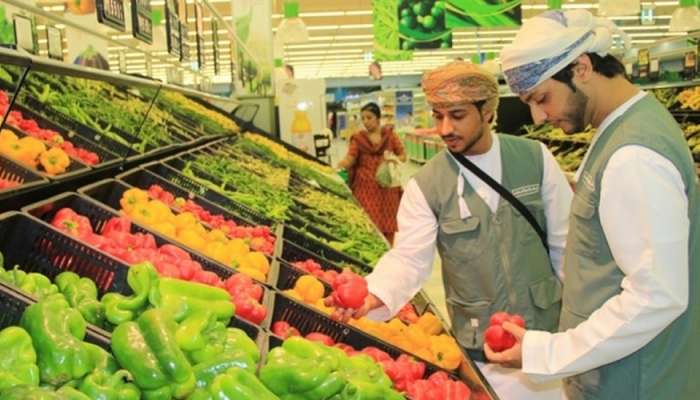
Muscat: The Sultanate of Oman witnessed an average inflation rate of 0.81 percent during the first five months of 2025 compared to the same period last year, according to the Consumer Price Index data released by the Ministry of Economy.
The report indicated a 1.3 percent increase in the general import price index and a 4.1 percent rise in the producer price index by the end of the first quarter of 2025 compared to the corresponding period in 2024.
Geographical distribution showed varying inflation rates across governorates, with South Al Batinah recording a marginal decline of 0.04 percent, while Al Dakhiliyah registered the highest rate at 1.58 percent, followed by Musandam at 1.51 percent and South Al Sharqiyah at 1.24 percent. More moderate increases were seen in North Al Sharqiyah (0.21 percent) and North Al Batinah (0.42 percent), with other governorates remaining below one percent.
Dr. Salim Abdullah Al-Sheikh, official spokesperson for the Ministry of Economy, stated that the moderation in consumer price inflation was driven by declining prices in the food and non-alcoholic beverages category alongside stable housing, water, electricity, gas, and fuel prices. These two categories account for over half of the consumer price index weight in Oman.
He pointed out that detailed inflation data revealed a 0.17% decrease in food and beverage prices between January-May 2025 compared to the same period last year. Significant price reductions were recorded for vegetables (-4.63%), seafood (-3.69%), meat (-0.13%), non-alcoholic beverages (-0.11%), and bread/cereals (-0.01%). Conversely, sugar/jam/honey/sweets rose 3.13%, dairy/eggs increased 2.88%, fruits grew 1.05%, oils/fats climbed 1.28%, and other food items jumped 3.40%.
He added that the miscellaneous goods/services category showed the highest inflation at 6.04%, followed by healthcare (2.71%), transport (2.68%), and restaurants/hotels (1.08%). Tobacco and communications prices remained stable with minimal increases in other CPI components.
Al-Sheikh attributed food price stability to moderated global commodity trends and sustained government subsidies on essentials, coinciding with progress in Oman's Tenth Five-Year Plan (2021-2025) food security strategy. This strategy enhances domestic food production, processing, and marketing systems to boost agricultural/fishery output, increase self-sufficiency, and reduce food imports.
He pointed out that the agriculture and fisheries sectors grew 2.8% in 2024, contributing OMR987 million to GDP at constant prices, with growth accelerating to 7.6% (OMR273.6 million) in Q1 2025.
To strengthen food security, Oman has developed over 80 markets, slaughterhouses, and kiosks since 2021 under its governorates development program, he explained.
He said that current projects include the Slaughterhouse in Shaleem & Halaniyat Islands, Sinaw Resources Market, Dhofar's Agricultural Products Hub, and Duqm's Food/Fishery Industrial Complex with cold chain facilities. The "Silal" Central Market in Barka in South Al Batinah, operational since 2024, serves as advanced distribution channel for local farm produce.
Meanwhile, the FAO Food Price Index recorded a year-on-year increase of 7.2 points (6.0%) in May 2025 compared to the same month last year. On a monthly basis, the index averaged 127.7 points in May 2025, reflecting a slight decline of 1.0 point (0.8%) from April 2025. This movement was driven by rising prices in dairy and meat products, while cereals, sugar, and vegetable oils experienced price declines.
Economic observers have expressed growing concerns about potential resurgence in inflation should trade protectionism policies intensify. Such developments could undermine the efforts of central banks that have successfully achieved significant inflation reduction since last year.
The US Federal Reserve expected that tariff increases implemented in April might lead to price hikes later this year, though the full impact has not yet materialised in inflation figures. While US inflation has declined substantially from its 2022 peak, it remains above the Fed's 2% target.
At its June meeting, the Federal Reserve maintained its benchmark interest rate at 4.25-4.5%, unchanged since December 2024, while signaling potential for two rate cuts in 2025. It simultaneously revised its inflation forecast upward to 3% for 2025 and lowered its U.S. GDP growth projection to 1.4%.
Within the same context, the International Monetary Fund, in its April 2025 World Economic Outlook report, adjusted its global inflation projections upward to 4.3% for 2025 and 3.6% for 2026. The report anticipates stronger inflationary pressures in advanced economies, contrasting with expected moderation in some emerging markets and developing economies.